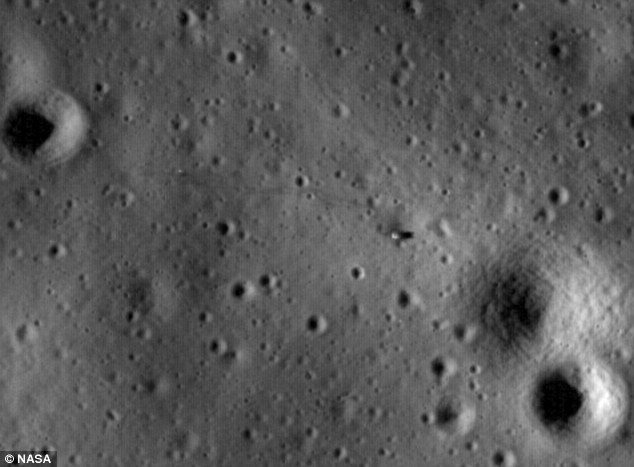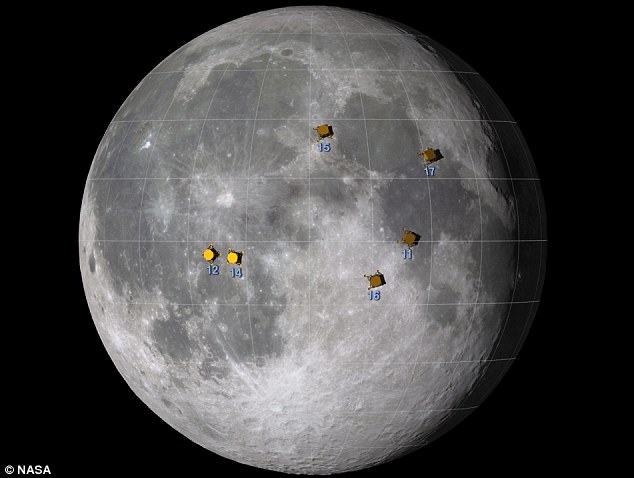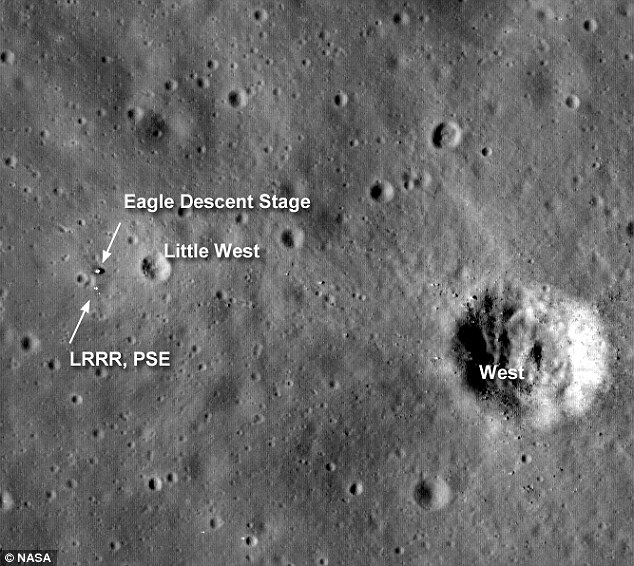In 2002, a frustrated Mr Aldrin even punched a documentary maker who claimed the Moon missions were faked.
Now new photos taken by Nasa's Lunar Reconnaisance Orbiter (LRO) camera may settle the matter once and for all.
The probe swept just 31miles above the lunar surface and captured images of the famous Apollo 11 landing site. The images, which were released this month, reveal the TV camera, Lunar Module descent stage and even Armstrong's footsteps to the Little West crater.
You can also identify two parts of the Early Apollo Science Experiments Package including the Lunar Ranging Retro Reflector, which is still used today to work out the daily distance between Earth and the Moon.
This is the second time the LRO has swept the site, but this time the Sun was 28 degrees higher in the sky, making smaller shadows and bringing out subtle brightness differences on the surface.


'They demonstrate how LRO will be used to identify the best destinations for the next journeys to the Moon.'
Five of the six Apollo sites were first glimpsed in July this year before the spacecraft was in its final mapping orbit.
All have a resolution of around four feet per pixel. The Apollo relics fill an area of about nine pixel and because the sun was low to the horizon the shadows fill around 20pixels.
The image taken of Apollo 14 is particularly impressive. The Lunar Module Antares is clearly visible as are the astronauts footprints leading to the scientific experiments away to the left of the picture.
'It's great to see the hardware on the surface, waiting for us to return,' said Mark Robinson, principal investigator for LRO.
Nasa hopes to launch a manned mission to the Moon in 2020, but this is heavily dependent on finding the budget. A U.S government panel have estimated the current human spaceflight plan would cost £60billion in spending to 2020.
Over the years conspiracy theorists have pointed to various pieces of 'evidence' that prove the landings were faked.
Many have questioned why no photos on the landing sites had been taken by telescopes or satellites that have orbited the Moon. The LRO is the first Nasa craft to return to the Moon since Apollo. It remains to be seen whether its latest photos will sway determined dissenters.
Popular Conspiracy Theories Answered:
Why are no stars visible in the Apollo photos?
The Apollo landings took place during lunar mornings so the stars were not bright enough to be captured on camera.
Who filmed Neil Armstrong take the first steps?
A video camera was fixed on an extending arm to swing out and capture the historic moment.
Why did the heavy Landing Modules make no impression on the surface, while the astronauts' footprints did?
The layer of lunar dust on the rocky moon is thin, so was blown away from the landing area by the descent engines. This dust resettled by the time the astronauts left the module.
Why does the flag wave?
It was rigged with a rod and wires so that it would look as if it was unfurled and blowing in Apollo photographs.
Why didn't the Lunar module show a flame when it took off from the Moon?
The fuel used does not produce a flame in a vacuum.




Reader Comments
to our Newsletter